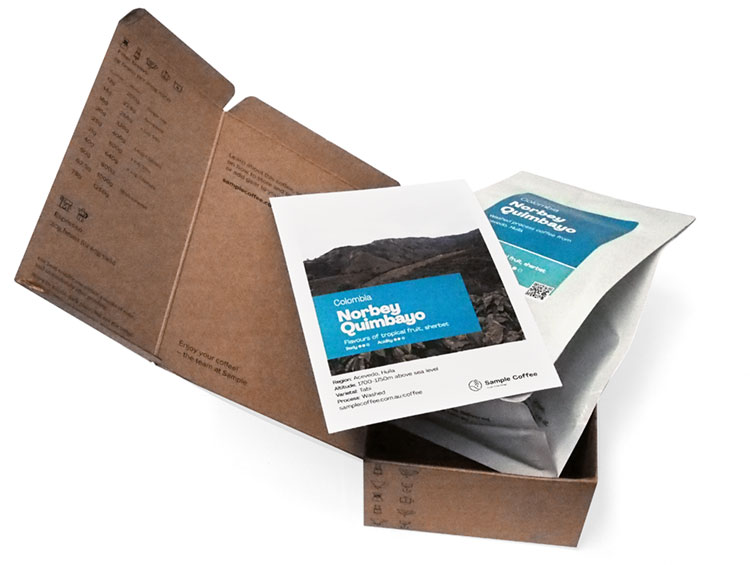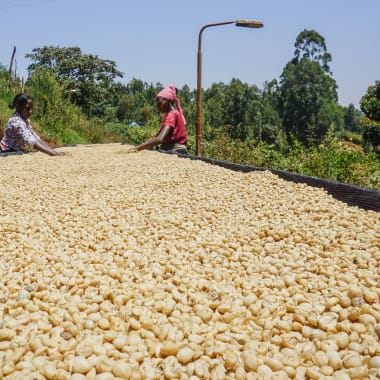-
Producer
-
Alejo Castro Khale
-
Farm/Coop
-
Finca Volcán Azul
-
Country
- Costa Rica
-
Region
-
Tarrazú
-
Altitude
-
1500-1700m above sea level
-
Variety
-
Process
-
Importer
-
Condesa Co.Lab
-
Body
-
-
Acidity
-
-
Tasting notes
-
Campari, raspberry and bubble gum
-
Roast style
Costa Rica
Finca Volcán Azul
GeshaA super clean anaerobic natural process Gesha by a globally-respected producer: Mr Alejo Castro! It makes us dream of Campari, raspberry and bubble gum.
A super clean anaerobic natural process Gesha from a globally-respected producer. The cup makes us dream of Campari, raspberry and bubble gum!
VERY SPECIAL
Or should we say Very, Very Special?
To start with, it’s an Anaerobic Natural process Gesha varietal. If you’re a beginner in the world of coffee, we explain more about what those mean below; if you’re a seasoned member of the Sample Coffee community, you know that’s a rare and precious thing!
Then, it’s the producer—Alejo Castro Khale from Finca Volcán Azul. He is a descendant of Alejo C. Jiménez, who got into the coffee business in Costa Rica at the beginning of the 19th century and is a renowned specialty producer and communicator.
For all these reasons and its clean and complex flavour profile (Campari, bubble gum!!), this coffee is our choice for this December’s Brew Crew VS edition.

ABOUT THE PRODUCER
In the words of the producers themselves: “In the early 19th century, when coffee production was just taking root in America, two pioneers and entrepreneurs, Alejo C. Jiménez in Costa Rica and Wilhelm Kahle in the south of Mexico, unknowingly shared the same dream: ‘To produce the best coffee in the world’ to satisfy the new and discerning European gourmet market. Today, the descendants of these visionary farmers continue to produce coffee with the same ideals of excellence and top quality that inspired their ancestors in Costa Rica.
Nowadays, the descendants of Don Alejo C. and Don Wilhelm aim to further enhance the principles of quality inherited from their founders by adding the value of conservancy of natural resources. This involves acquiring extensions of natural rainforest for protection and conservation—a tangible contribution to reducing air contamination and global warming.
These actions, not just words, represent the small steps taken by one family to benefit mankind and pass on a new awareness to future generations. Currently, the farm is managed by Alejo Khale Castro. His dedication to quality and innovative drive have consistently positioned Volcán Azul in Coffee of Excellence competitions!

Here’s an interview with April Coffee Roasters in Denmark:
ABOUT THE VARIETAL
Gesha (also known as Geisha) is a variety known for its exceptional cupping quality, but also for its susceptibility to diseases and low yield potential. This combination has made it a precious produce, paid almost the highest in the coffee trade market.
"This variety was originally collected from coffee forests in Ethiopia in the 1930s. From there, it was sent to the Lyamungu research station in Tanzania, and then brought to Centro Agronómico Tropical de Investigación y Enseñanza (CATIE) in Central America in the 1953, where it was logged as accession T2722. It was distributed throughout Panama via CATIE in the 1960s after it had been recognised for tolerance to coffee leaf rust. However, the plant’s branches were brittle and not favored by farmers so it was not widely planted. The coffee came to prominence in 2005 when the Peterson family of Boquete, Panama, entered it into the "Best of Panama” competition and auction. It received exceptionally high marks and broke the then-record for green coffee auction prices, selling for over $20/pound.
[…]It is associated with extremely high cup quality when the plants are managed well at high altitude, and is known for its delicate floral, jasmine, and peach-like aromas.
As of December 2023, our team has agreed to use the ‘Gesha’ variation when referring to this variety (previously we had written the version given by the coffee importer).
“The spellings Geisha and Gesha are often used interchangeably, relating to the fact that there is no set translation from the dialects of Ethiopia to English.
The coffee was first recorded in germplasm records with the spelling “Geisha,” and coffee researchers and germplasm banks have mostly maintained that spelling over many decades, leading that spelling to be promoted and used first in the coffee industry.
The coffee was originally collected in Ethiopia in a region close to a mountain whose name is most commonly rendered in English as Gesha. Consequently, many in the coffee industry have preferred to rescue that spelling.”
Source of above varietal info: World Coffee Research
More on the spelling dilemma and trends: Stop Calling It “Geisha” Already - Sprudge
ABOUT THE HARVEST AND PROCESS
Pre-harvest: This is the part of the process that receives less attention, yet it’s probably the most important in processing great quality coffee. Constant hard work over the years is essential because even a short period of neglect can spoil all the work done. To develop a well-rounded coffee bean with complex flavours, it’s crucial to plant the best varieties, maintain healthy soil, protect plantations from diseases, and ensure sustainability for constant high quality over the years.

Harvest: It’s fundamental that we pick the cherries at the optimum level of ripeness. This allows us to have more complex flavours in our cup of coffee. We measure the brix content of the mucilage of the coffee cherries to determine the best time to pick them. Usually, we start at 22 brix content (depending on the variety, but we have had measurements of 28 or even 30).
Wet mill: The first step is to measure the cherries coming from the plantation by truck or tractor. We measure the cherries by volume using a 200-litre box; two of these give us one fanega (400 litres), resulting in approximately 46 kg of green coffee. After this, we separate floaters, which are typically unripe, overdried, or defective cherries. At this step, we also clean the coffee from branches, leaves, dirt, and any other foreign matter from the field. We then decide on the process for the harvested lot. It’s crucial to slow-dry our coffee to preserve quality. More mucilage, pulp, and time mean more fermentation during the drying process.

Processing - Anaerobic: We use anaerobic tanks with a valve that lets the oxygen out, replaced with CO2. We develop different recipes by measuring time, temperature, pH or acidity of the mucilage, and brix content of the mucilage inside the tank. It’s important to note that we don’t add anything strange to this process; we aim to develop or enhance flavours naturally present in our coffee with the help of autochthonous yeast from our farm. After this, the coffee is taken to the drying patio or raised beds, stirred each day from 8 am to 2 pm. At 2 pm, we start covering the coffee with plastic to maintain warmth during the night and prevent humidity absorption from the morning mist. This process takes around 16 days, depending on the weather.

Learn everything about this coffee:
Ethical, traceable sourcing
This page has all the sourcing information (variety, process, region, story, importer, and more) that our importers share with us, and give us permission to use.
The transparency helps us talk confidently about the quality and background of our product, and it helps you know exactly what you’re buying.
Learn more:
Coffee page transparency legend
Our coffee philosophy
Our business approach
Fresh harvest coffee
We only source and roast coffee from each country’s latest harvest season (so the green coffee is never older than 1 year from the time of picking, processing and packing). This ensures the sensory qualities are always at their peak and unaffected by excessive ageing.
Roasted for espresso and filter (best enjoyed black)
Roast style: omni. Omni roasts are designed to brew and taste great both as espresso and filter. Our omni single origins generally sit on Agtron values in the ~70-60 value range. So, technically, they are somewhere in the lighter side of the medium spectrum.
Designed for espresso and filter brewing. Best enjoyed black.
Learn more:
Our Loring Kestrel S35 roaster
Our roasting style and approach
Best brewed within days 15-49 post-roast
The ‘fresh is best’ saying doesn’t apply to coffee (contrary to popular belief). Waiting before opening and brewing your bag of whole coffee beans helps develop peak flavour and acidity.
But heads up: if you buy pre-ground coffee, brew it as soon as possible.
Learn more:
Our recommended brewing window
Try our custom brewing recipes
Our recipes and ratios are tailored to our coffee sourcing and roasting styles, bringing the best flavour and feel out of each coffee.
For pour over, immersion, and other filter brewing styles, check our brew guides.
For our espresso single origins, we recommend a coffee:yield ratio of 1:3:
- Dose: 20g ground coffee
- Yield: 60g espresso
- Total brew time: ~24-28 seconds
This is just a starting point! We encourage you to experiment, taste, and adjust to find the recipe that you enjoy the most.
Learn more:
Our espresso brew guide (single origin)
Brewing ratio calculator
Packaging and sustainability
- Bags: ABA-certified home compostable (AS 5810-2010)
- Labels: recyclable
- Valves (only on +250g bags): general waste
- Box and tape (online orders): recyclable
Learn more:
Our packaging
Variety
Gesha variety
An exceptionally high quality variety that has grown in popularity, Gesha is named after the town of Gesha in Ethiopia where the seeds originated.
The location
Coffee from Costa Rica
Since the mid-2000s there has been an increasing focus on the establishment of micro-mills in Costa Rica to increase their production of traceable, high quality lots of coffee.
The Tarrazú region of Costa Rica
The area generally considered to produce the highest grade coffee in Costa Rica. Farmers from other regions are known to market their coffee as ‘Tarrazú’ due to the strength of the name
Farm processes
Anaerobic Natural process
This technique leaves some flesh on the coffee cherry during processing and drying. This results in flavours which may show jammy fruit and a little winey-ness.

Subscribe to a world of coffee
Discover a new single origin coffee from Sample every 1-5 weeks with no delivery fees.
No up-front purchase, and you can pause, cancel, or change plans at any time.
Available to order online this week:

Nicaragua Guillermo Montenegro
Flavours of plum, nectarine, shortbread
Body Acidity
Washed Caturra
March 2025 harvest
Roasted omni for filter and espresso
Nicaragua Guillermo Montenegro online
Ethiopia Bekele Gemeda
Flavours of mandarin, white peach, mango
Body Acidity
Washed Ethiopian Heirloom
November 2024 harvest
Roasted omni for filter and espresso
Ethiopia Bekele Gemeda online
Kenya Karindundu Aa
Flavours of orange marmalade, grapefruit, Yunnan red tea
Body Acidity
Washed Batian, SL28, SL34, Ruiru 11
Roasted omni for filter and espresso
Kenya Karindundu Aa online
Ethiopia Girma Sintayehu Honey
Flavours of apricot, mango, coconut, pineapple
Body Acidity
Honey 75227, Wolisho
February 2025 harvest
Roasted omni for filter and espresso
Ethiopia Girma Sintayehu Honey online